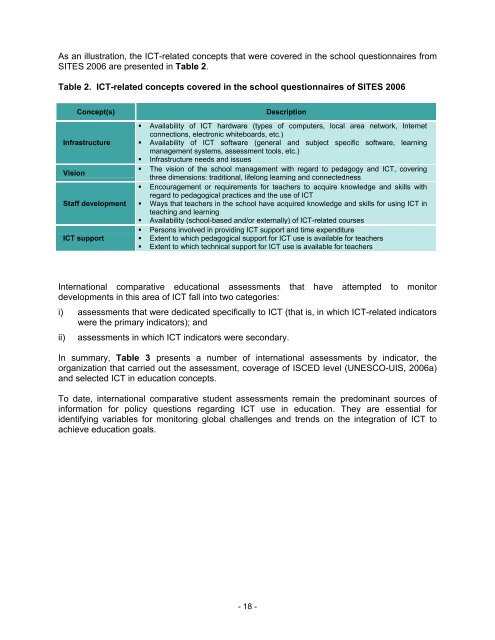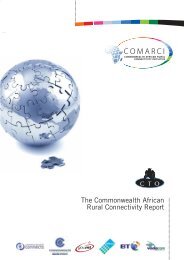Guide to measuring information and ... - unesdoc - Unesco
Guide to measuring information and ... - unesdoc - Unesco
Guide to measuring information and ... - unesdoc - Unesco
Create successful ePaper yourself
Turn your PDF publications into a flip-book with our unique Google optimized e-Paper software.
As an illustration, the ICT-related concepts that were covered in the school questionnaires from<br />
SITES 2006 are presented in Table 2.<br />
Table 2. ICT-related concepts covered in the school questionnaires of SITES 2006<br />
Concept(s) Description<br />
Infrastructure<br />
Vision<br />
Staff development<br />
ICT support<br />
Availability of ICT hardware (types of computers, local area network, Internet<br />
connections, electronic whiteboards, etc.)<br />
Availability of ICT software (general <strong>and</strong> subject specific software, learning<br />
management systems, assessment <strong>to</strong>ols, etc.)<br />
Infrastructure needs <strong>and</strong> issues<br />
The vision of the school management with regard <strong>to</strong> pedagogy <strong>and</strong> ICT, covering<br />
three dimensions: traditional, lifelong learning <strong>and</strong> connectedness<br />
Encouragement or requirements for teachers <strong>to</strong> acquire knowledge <strong>and</strong> skills with<br />
regard <strong>to</strong> pedagogical practices <strong>and</strong> the use of ICT<br />
Ways that teachers in the school have acquired knowledge <strong>and</strong> skills for using ICT in<br />
teaching <strong>and</strong> learning<br />
Availability (school-based <strong>and</strong>/or externally) of ICT-related courses<br />
Persons involved in providing ICT support <strong>and</strong> time expenditure<br />
Extent <strong>to</strong> which pedagogical support for ICT use is available for teachers<br />
Extent <strong>to</strong> which technical support for ICT use is available for teachers<br />
International comparative educational assessments that have attempted <strong>to</strong> moni<strong>to</strong>r<br />
developments in this area of ICT fall in<strong>to</strong> two categories:<br />
i) assessments that were dedicated specifically <strong>to</strong> ICT (that is, in which ICT-related indica<strong>to</strong>rs<br />
were the primary indica<strong>to</strong>rs); <strong>and</strong><br />
ii) assessments in which ICT indica<strong>to</strong>rs were secondary.<br />
In summary, Table 3 presents a number of international assessments by indica<strong>to</strong>r, the<br />
organization that carried out the assessment, coverage of ISCED level (UNESCO-UIS, 2006a)<br />
<strong>and</strong> selected ICT in education concepts.<br />
To date, international comparative student assessments remain the predominant sources of<br />
<strong>information</strong> for policy questions regarding ICT use in education. They are essential for<br />
identifying variables for moni<strong>to</strong>ring global challenges <strong>and</strong> trends on the integration of ICT <strong>to</strong><br />
achieve education goals.<br />
- 18 -
















